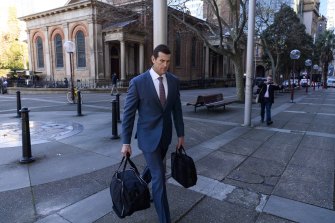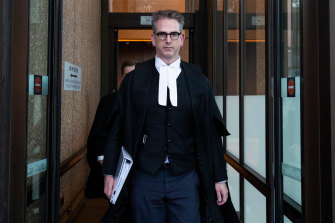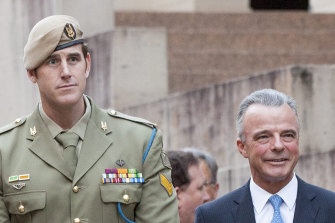Home » World News »
Media’s barrister circles Ben Roberts-Smith, campaign by campaign
As the first fortnight of the Ben Roberts-Smith defamation trial drew to a close it became clear why, as the lawyers predicted, this epic clash could run for another eight weeks or longer.
It was not until Thursday morning that Nicholas Owens, SC, the barrister for The Age, The Sydney Morning Herald and The Canberra Times was able to begin cross-examining the towering former soldier, whose first days in the witness box had been spent under the sympathetic questioning of his own barrister, Bruce McClintock, SC.
Roberts-Smith had come across as a disciplined and articulate performer on the stand. Now it was up to Owens to try and take his story apart.
Ben Roberts-Smith arrives at court in Sydney on Friday.Credit:Rhett Wyman
By Friday morning, the barrister for the media outlets was starting to move in on his quarry, putting to a periodically rattled-looking Roberts-Smith that parts of his evidence were “implausible” and lies, doubling back again and again over the testimony the ex-soldier had given, picking out inconsistencies, gaps in memory, and growing uncertainties about who in the SAS field of operations had done what, when and where.
Roberts-Smith denies any falsehoods. He says he is an honourable man, devoted to his country, who served with valour and distinction in Afghanistan and who – contrary to the allegations of the media outlets – never murdered or connived in the murder of six prisoners and never committed an act of domestic violence against his one-time lover.
He spoke during the week about the “nightmare” he’d been living since the allegations against him were first published three years ago, detailing the impact on his reputation and his family, the fears about the effect of his public disgrace on his children and parents, the loss of income that followed the cancellation of the many speaking engagements he’d once enjoyed, and the loss of a lucrative job offer with big four consultancy firm, PwC.
Lawyer Nicholas Owens has a big job ahead of him.Credit:Edwina Pickles
Initially he probed Roberts-Smith’s understanding of the international rules of warfare – reflected in Australia’s rules of engagement – which require protection to be given to combatants (or suspected combatants) who’ve been disarmed and rendered Persons Under Control (or PUCs in military jargon).
Yes, Roberts-Smith said, he understood those rules. And yes, he agreed he’d be complicit in a crime if he killed or assaulted a PUC, or stood by as another soldier ordered or committed such an action.
Owens then took him through the intricate detail of how Australian special forces handled villagers, women, children, “fighting age males” (or FAMs) and prisoners during their sweeps through Afghan settlements and compounds, before turning to several key events which lie at the heart of the newspapers’ published allegations.
One, in 2012, centres on the death of a man described by Roberts-Smith as a Taliban “spotter”, whom he says he helped kill in a cornfield in the vicinity of a dry creek-bed near the village of Darwan. The media outlets say that individual was really a harmless farmer named Ali Jan, kicked down a cliff by Roberts-Smith who then either shot him or stood by as another soldier did so before their SAS patrol exited the area by helicopter.
Crucial timing differences
On Friday Roberts-Smith shifted uncomfortably in the witness box as he was asked to accept that a crucial time window he’d first estimated as being around 10 minutes long was, in fact, much longer, perhaps up to one and half hours.
He was challenged on why the supposed “spotter” hadn’t already been flushed out by troops on each side of the creek bed, who were carrying out detailed searches of the area.
Then came a tussle with Owens over the meaning of the word “cliff”. Roberts-Smith agreed there’d been “very steep terrain” near where he’d been operating. But, he told the media’s barrister, “a cliff is a cliff and that is not a cliff to me.”
After challenging nearly every detail of the incident as described by Roberts-Smith, Owens moved to the crunch: “I want to put it to you that you have invented the story of the [spotter] in the cornfield”. “No” Roberts-Smith replied.
A second incident, also central to the media outlets’ defence, turns on the death of an insurgent with an artificial leg which occurred during an SAS search of a compound designated Whisky 108 in 2009.
At the time, Roberts-Smith was second in command of a patrol dubbed Gothic 5. Roberts-Smith says he rounded a wall outside the compound in the course of the search operation and encountered the man carrying a weapon, at which point he opened fire and killed him. But the media outlets assert Roberts-Smith machine-gunned the man when he’d already been rendered harmless.
On Friday morning, Roberts-Smith amended one key aspect of the evidence he’d given the previous day on this incident, denying (when challenged by Owens) that he’d spoken to anyone about it overnight. Owens put forcefully to the Victoria-Cross winner that his account of this incident was also concocted – a charge denied by the former soldier.
Owens has been getting Roberts-Smith, step by step, to reconstruct his exact movements through these and four other contested events in a time frame between 2009 and 2012. Maps, diagrams, photos and satellite images have been repeatedly handed to the former soldier, with Owens asking him to mark his position at different stages of each operation.
The meticulous scene-setting will no doubt play a central role when Nine (owner of the Age and the Herald) calls a number of former SAS colleagues of Roberts-Smith’s to testify against him down the track.
The witness list shows it will also call his former wife, Emma Roberts, and his former lover, a married woman identified only as Person 17 with whom he had an affair in late 2017 and early 2018.
In another extraordinary development in this already extraordinary case, Andrew Hastie – a former SAS captain who served in Afghanistan and is now the assistant minister for defence – is listed as a “likely” witness for the media outlets while former minister for defence Brendan Nelson will give evidence for Roberts-Smith.
Nelson was one of the first to ring and commiserate with Roberts-Smith when the first articles appeared on a June weekend in mid-2018, the ex-soldier told the court this week.
“He was disgusted with what had been written. And he had identified that it was talking about me.”
This was a reference to the fact that the initial articles had not identified Roberts-Smith by name, but through the pseudonym “Leonidas” after a warrior of ancient Sparta. (The ex-soldier has a Spartan helmet tattooed across part of his chest). Roberts-Smith says this and other clues in the text made clear he was the subject of the allegations, and a subsequent article, in August of that year, did identify him by name.
Ben Roberts-Smith and then director of the War Memorial, Dr Brendan Nelson. Credit:ADF
Roberts-Smith’s legal team have flagged they have up to 14 former and serving SAS soldiers who will support his version of events. The newspapers have up to 21 military witnesses listed. While this will make for riveting theatre for the rest of the country, it will be extremely uncomfortable for leaders of the ADF as soldier is pitched against soldier, and former comrade against former comrade.
Roberts-Smith’s alleged misdeeds in Afghanistan are not the only aspects of his behaviour under scrutiny in this trial. McClintock took the tactical decision to get his client’s version of a range of other events, which occurred after he left the army, on the record this week before they could be dredged up by Owens.
These include Roberts-Smith’s decision to hire private investigator John McLeod to spy on his former lover as she visited an abortion clinic in early 2018 and his use of the same PI to try and find the home addresses of soldiers he thought were briefing against him.
Owens in his opening address accused Roberts-Smith of using prepaid “burner” phones to secretly collaborate with former army colleagues in an attempt to “undermine the integrity of the evidence” against him. But Roberts-Smith says he was just trying to protect his privacy, fearful that calls with colleagues would be intercepted by the media. He was also trying to work out which of his one-time SAS comrades were “trying to poison the well” against him.
He conceded comparing notes with other former soldiers, saying “the kind of thing we would talk about is, for example, where we got dropped off, what our route was moving into position, who assaulted which areas of the compound … whether it was night or day. Just basically looking at what had been written, because most of it was wrong and false.”
Owens’ cross examination of Roberts-Smith will continue into next week, before the one-time war hero calls the first of his witnesses to speak in defence of his reputation.
The Morning Edition newsletter is our guide to the day’s most important and interesting stories, analysis and insights. Sign up here.
Most Viewed in National
From our partners
Source: Read Full Article





